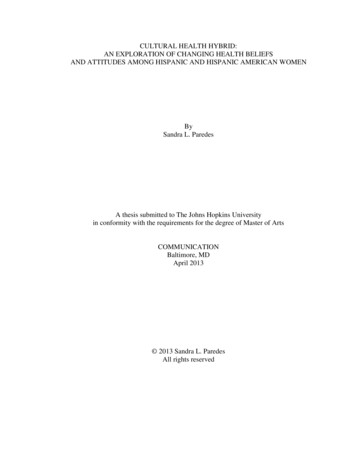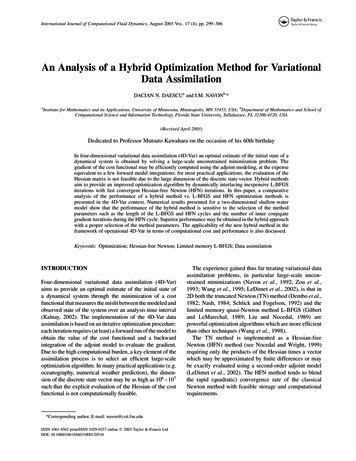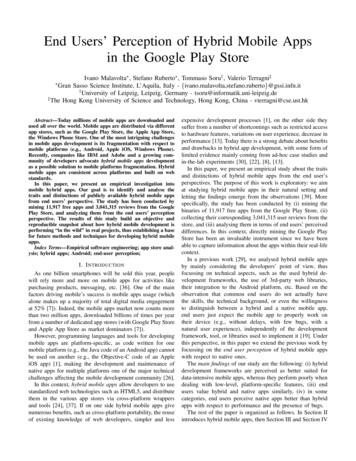
Transcription
CULTURAL HEALTH HYBRID:AN EXPLORATION OF CHANGING HEALTH BELIEFSAND ATTITUDES AMONG HISPANIC AND HISPANIC AMERICAN WOMENBySandra L. ParedesA thesis submitted to The Johns Hopkins Universityin conformity with the requirements for the degree of Master of ArtsCOMMUNICATIONBaltimore, MDApril 2013 2013 Sandra L. ParedesAll rights reserved
AbstractUsing two focus groups with 8 Hispanic and 9 Hispanic American women, this studycompared health beliefs and attitudes between Hispanic and American women. Thisstudy identified strategies that both groups of women use to negotiate health informationfrom two distinct health cultures: traditional Hispanic culture and American clinicalculture. Findings indicate that both Hispanic and Hispanic American women see healthas having a physical and psychological component, see themselves as responsible forprotecting their health, and practice preventive behaviors. However, Hispanic Americanwomen do not believe in culture-bound syndromes the way Hispanic women do, nor doHispanic American women believe in a connection between culture-bound syndromesand chronic disease. Interestingly, both groups of women adapt to a clinical healthculture in their own way. Hispanic women adopt clinical practices while maintainingtheir traditional practices. In contrast, Hispanic American women pick and choosepractices from traditional and clinical health culture. This study proposes the theory ofcultural health hybrid to examine changing health attitudes and beliefs in Hispanic andHispanic American women.Thesis Readers:Jane Twomey, Ph.D.Paula Weissman, Ph.D.ii
PrefaceDedicated to my grandmother, Nohemy Largacha, whose unwavering faith andsupernatural strength were the inspiration for this research study, and to my mother,Stella Rubin, whose insatiable quest for health information is a model for engagedpatients.I would like to thank Jane Twomey, Ph.D. and Mary Miscally, Dr.P.H. for theirguidance through the iterative process that culminated in this paper. I also thank MarianaSerrani for her Spanish-language assistance and translation certification. Finally, I thankJason Decker for his advice, patience, and motivation; and Stella and Phil Rubin for theirloving encouragement and support.iii
Table of ContentsAbstract . iiPreface. iiiIntroduction . 1Cultural Health Hybrid . 4Literature Review. 6Beliefs and Attitudes as Barriers to Health Self-Efficacy . 6Changing Health Beliefs and Attitudes. 11Research Questions . 13Method . 14Participant Recruitment . 15Procedures . 17Data Analysis . 19Results . 20Participant Description. 20Shared Health Beliefs and Attitudes . 21Differences in Health Beliefs and Attitudes . 23Strategies to Negotiate Health Cultures . 27Discussion . 32Implication of Findings . 32Emerging Attitudes . 33Cultural Health Hybrid . 34Limitations . 36Implications for Further Research . 37Appendices . 39References . 63Curriculum Vitae . 69iv
Cultural Health Hybrid: An Exploration of Changing Health Beliefs and AttitudesAmong Hispanic and Hispanic American WomenIn 2010, Hispanics made up 16.4% of the United States population, a markedincrease compared to 12.5% in 2000. U.S.-born Hispanics contributed the most to thisincrease, from 7.5% in 2000 to 10.3% in 2010. By comparison, the number of foreignborn Hispanics increased slightly from 5% to 6.1% during the same time period. Thistranslates into almost 32 million Hispanic Americans and 18 million Hispanics living inthe United States in 2010 (Motel, 2012). Currently, U.S.-born Hispanics outnumberforeign-born Hispanics. In this paper, I will use the term Hispanic to refer to people whoimmigrated to the United States as adults and Hispanic American to describe people bornin the United States to Hispanic parents or who immigrated as children. These two termsinclude synonymous classifications, such as Latino/a, Chicana, and Mexican American,which are often used to refer to Hispanic Americans.Hispanic culture influences health care decisions and patient-doctorcommunication. Doctors are deemed worthy of respect by virtue of their authority, socialposition, and education (National Alliance for Hispanic Health, 2001). Respect fordoctors manifests itself in patients assuming a passive role in health decisions. This iscontrary to American health culture, which encourages patients to play an active role intheir health care (Talavera, Elder, & Velasquez, 1997). Respect in Hispanic cultureimplies not asking questions, even if a patient does not understand a diagnosis orprescription, nor voicing disagreement about treatment recommendations (NationalAlliance for Hispanic Health, 2001). Therefore, Hispanic culture can create barriers inpatient-doctor communication.1
Some health beliefs and attitudes prevalent in Hispanic culture may create barriersto health self-efficacy (Ashing-Giwa, Padilla, Bohórquez, Tejero, & Garcia, 2006;Coronado, Thompson, Tejeda, & Godina, 2004; Pérez-Stable, Sabogal, Otero-Sabogal,Hiatt, & McPhee, 1992; Poss & Jezewski, 2002). Self-efficacy is the belief a person hasin his or her ability to perform a necessary activity (Bandura, 1977). Furthermore, beliefin one’s ability to successfully carry out a task also affects how a person will attempt tocope in a given situation. To explore the influence of beliefs and attitudes, I use thefollowing definitions: beliefs are the “probability dimension of a concept” —is itsexistence probable or improbable? And attitudes are the “evaluative dimension of aconcept”—is it good or bad? (Fishbein & Raven, 1962, p. 35).The American Psychiatric Association defines culture-bound syndromes as“localized, folk, diagnostic categories that frame coherent meanings for certain repetitive,patterned, and troubling sets of experiences and observations (American PsychiatricAssociation/Guarnaccia & Rogler, 1999, p. 1322). Culture-bound syndromes oftendescribe mental illnesses such as clinical depression and generalized anxiety disorder(Bayles & Katerndahl, 2009; Braun, 2008). Hispanics colloquially refer to these culturebound syndromes as ataque de nervios (nervous attack), nervios (nerves), susto (fright),and mal de ojo (evil eye). Hispanics and Hispanic Americans are more likely toexperience psychological distress than their non-Hispanic counterparts in the UnitedStates (Dey & Lucas, 2006). Hispanics believe culture-bound syndromes havesupernatural or mystical causes rather than clinical explanations, thus preventing themfrom seeking medical attention. In addition, Hispanics avoid talking to their doctorsabout symptoms they associate with culture-bound syndromes because they believe2
doctors will not know, understand, or accept such syndromes (Braun, 2008). This furthercreates a barrier in patient-doctor communication, and ultimately produces an obstacle toaccess treatment, especially in cases where a mental illness is the clinical explanation fora culture-bound syndrome.Prevalent health attitudes in Hispanic culture can lower people’s perception ofhealth self-efficacy. Fatalism is a common health attitude among Hispanics. Fatalisticpeople accept the perception of having little or no control over their health outcomes andtherefore do not engage in preventing or treating chronic disease because they see theeffort as futile (Chavez, Hubbell, McMullin, Martinez, & Mishra, 1995; Hubbell, Chavez,Mishra, & Valdez, 1996). Similarly, external locus of control is a common healthattitude, often manifested in God’s will (punishment or reprieve) and doctors’ healingability (Ashing-Giwa et al., 2006; Roncancio, Ward, & Berenson, 2011). Lastly, moralattitudes about sexual behaviors pose a barrier to health care. The misconception thatabortions cause cervical cancer, or that any cancer diagnosis is a punishment from Godfor bad behavior, also prevents Hispanic women from sharing health information withfamily and loved ones (Chavez, McMullin, Mishra, & Hubbell, 2001). Moral attitudescreate barriers because they prevent younger generations from knowing their familyhealth history and inhibit afflicted people, especially women, from seeking treatment oremotional support.Newer studies, however, suggest that beliefs and attitudes are changing,especially among Hispanics who have lived in the United States for decades and HispanicAmericans who grew up immersed in American culture. These two groups demonstratehigher self-efficacy when it comes to their health (Flórez, Aguirre, Viladrich, Céspedes,3
De La Cruz, & Abraído-Lanza, 2009). They are also more likely to attribute familyhistory as a risk factor for breast cancer (Chavez et al. 1995), and use preventive servicesmore frequently to detect breast and cervical cancer (Lara, Gamboa, Kahramanian,Morales, & Bautista, 2005).Cultural Health HybridThis study aims to propose cultural health hybridization as a theory to explore thechanging beliefs and attitudes among acculturated Hispanics and U.S.-born HispanicAmericans. In the late 1980s, the theory of cultural hybridization emerged as a strategythat allowed Latin America to compete in the modern era, yet retain folk customs as afingerprint of unique cultures (Canclini, 1989). Cultural hybridization was a possiblemechanism to expand and renew cultures. It is not a planned process, but rather a byproduct of the “migratory process” and “economic and communication exchange”(Canclini, 1997, p. 112).Observational learning, a process in which people see how others’ behaviors arereinforced, contributes to cultural health hybridization by allowing people to learn fromtheir social environments and adopt behaviors (Bandura, 2001). Observational learningis a natural process among families and “accounts for why people in the same familyhave common behavioral patterns” (Baranoski, Perry, & Parcel, 2002, p. 170). This mayalso explain how Hispanic Americans, despite growing up immersed in Americanculture, know of traditional Hispanic health beliefs and attitudes (Bayles & Katerndahl,2009). Observational learning is a mechanism for cultural health hybrids to incorporateattitudes that can lead to higher internal locus of control, thus resulting in higher healthself-efficacy (Zachariae et al., 2003).4
This study is important because culture greatly influences Hispanics’ andHispanic Americans’ experience of health care in the United States. The culturaldifference poses communication challenges for patients, doctors, health educators, andhealth campaign planners (Centers for Disease Control and Prevention, n.d.). However,as the evidence suggests, traditional Hispanic health beliefs and attitudes are changing.Therefore, researchers, communicators, and clinicians need to be culturally sensitive andaware of the health and attitude continuum among Hispanics and Hispanic Americans(Talavera et al., 1997).In this study, I compare Hispanic and Hispanic American women’s health beliefsand attitudes. I also identify strategies they use to negotiate health practices from twodifferent health cultures. Health communication professionals who design healtheducation campaigns can use the results of this study to inform campaigns for Hispanicaudiences. In addition, public health professionals can use these findings to furtherexamine the role of culture as part of social determinants of health outcomes. Lastly,clinicians can use these findings to augment their cultural competence training.5
Literature ReviewThis literature review summarizes studies that illustrate how health beliefs andattitudes affect health self-efficacy in Hispanics and Hispanic Americans. I also presentevidence that traditional health beliefs and attitudes are changing among some groups ofHispanics. Although, I used the Fishbein and Raven (1962) definition of beliefs andattitudes, there is still disagreement about their definition in the literature. Some wouldargue that the attitudes I present here have a dimension of belief in addition to an attitude.Therefore, I present beliefs and attitudes together. However, their importance here is thatbeliefs and attitudes are barriers to health self-efficacy.Beliefs and Attitudes as Barriers to Health Self-EfficacyCulture-bound syndromes are folk illnesses prevalent in Hispanic culture that canbe barriers to health self-efficacy. Many times, they are terms for psychological illnessesor symptoms of a clinical disease, but with supernatural causes associated to the cause.Mal de ojo is a culture-bound syndrome, often used to describe a variety of maladies ininfants. Susto is also a culture-bound syndrome described as a strong emotion caused bya frightening event, often attributed with precipitating the onset of type 2 diabetes.Argote and Vasquez (2005) interviewed adolescent mothers (n 8) in Cali,Colombia, a large metropolitan city, about their beliefs in culture-bound syndromes. Theresearchers found that the young mothers have a strong belief in culture-boundsyndromes, especially mal de ojo. Mothers expressed concern about protecting theirnewborns from mal de ojo to prevent mental retardation and malaise. They reported thestrict practice of blocking newborns from strangers’ line of sight to avoid malicious orunintentional mal de ojo. Participants listed the symptoms of mal de ojo as fever,6
vomiting, diarrhea, sweating, insomnia, weight loss, and swelling. In severe cases,respondents said they believed mal de ojo could cause mental retardation. Mothersoffered the following as treatments: prayer, seeking care from a folk healer, herbalcleansings, and avoiding milk and eggs.Findings from Gil and López’s (2007) interviews of women (n 20) in Turbo,Colombia, a small rural city, also support the previous study’s findings. The researchersobserved and interviewed mothers (mean age 28, age range: 17- 54) of young childrenabout their beliefs and experiences with mal de ojo and its relation to malnutrition. Theyfound that women listed diarrhea, vomiting, and fever as symptoms, and treatment asprayer, ritual baths, and herbal remedies. The researchers also found that mothersbelieved people could intentionally or unintentionally give a baby mal de ojo. If acommunity member envied the baby because he or she was cute or happy, they couldintentionally give the baby mal de ojo. Women also believed that a doting father couldunintentionally give their child mal de ojo, if the father carried the baby while still sweatyfrom being outdoors or was excessively attentive to the child. Women in this studynoticed that their babies dramatically lost or gained weight after they contracted mal deojo, indicative of a symptom associated to malnutrition or edema (swelling).Poss and Jezewski (2002) explored the role of susto in perceived causes ofdiabetes using focus groups with Mexicans (n 18) and Mexican Americans (n 4) in aTexas border town. Eligible study participants had lived with diabetes for an average of14 years and were enrolled in diabetes education classes. Despite participating in theseclasses, participants still believed that strong emotions (happy or sad) had triggered theonset of their diabetes. Almost all could remember a specific frightful event or susto to7
which they attributed the onset of their disease. Common susto events include a caraccident, witnessing a death by gunfire or drowning, being threatened with a gun, or thesudden death of a family member.In a later study, Coronado et al. (2004) found similar results from focus groupdiscussions with Mexican Americans (n 42) living in Washington state. Participantsoffered diabetes risk factors and symptoms consistent with clinical medicine. Riskfactors included heredity, a diet high in fat and sugar, and obesity. Symptoms includedincreased thirst, urination, and tiredness. However, some participants concurrentlybelieved that culture-bound syndromes such as susto or coraje made them susceptible todiabetes. Similarly, when asked about diabetes treatment, participants offered bothclinical treatments (diet changes, more exercise, oral medication, insulin) and folktreatments (cactus juice, aloe vera, and violet water).These studies show how deeply culture-bound syndromes such as mal de ojo andsusto are entrenched in Hispanic culture, even among Hispanics living in the UnitedStates and Hispanic Americans. Culture-bound syndromes may mask underlying medicalconditions, thus delaying medical care and disease management. Furthermore, theirsupernatural attributes prevent people from seeking medical attention, creating a barrierto perceived health self-efficacy.In addition to health beliefs, Hispanics and Hispanic Americans have specificattitudes that create a barrier to their health self-efficacy. People with fatalistic attitudesbelieve there is little or nothing they can do to prevent disease and illness. Some have anexternal locus of control, meaning they believe others have the power to determine theirhealth outcomes. Examples of powerful others are God and doctors (Borrayo, &8
Guarnaccia, 2000). Lastly, moral attitudes create a barrier because people withholdinformation from family members and doctors to avoid shame and judgment when theybelieve others will perceive them as engaging in morally questionable behaviors.In a seminal study, Pérez-Stable et al. (1992) randomly surveyed Hispanics(n 486) and Hispanic Americans (n 358) in San Francisco about their cancer attitudesand compared them to the attitudes of Anglo Americans (n 510). Among Hispanic andHispanic American respondents, 46% saw cancer as a punishment from God, and 46%perceived cancer as a death sentence. Twenty-six percent believed that there was littlethey could do to prevent cancer. Hispanics’ and Hispanic Americans’ responses showedthat they have higher fatalistic attitudes and a higher external locus of control ascompared to Anglo Americans (p 0.001).Similarly, Ashing-Giwa et al. (2006) found that Hispanic breast cancer survivors(n 26) perceived God as a powerful locus of control. The researchers recruited aconvenience sample of Hispanic women (mean age 56), to participate in focus groups inLos Angeles. Researchers found that culture affects Hispanic women’s attitudes abouttheir well-being. Women’s coping mechanisms to survive breast cancer includedaccepting God’s will and believing in the strength of prayer for healing. Women oftensaw prayer as a path to a cure; some even discontinued breast cancer treatment becausethey strongly believed that God would cure them. In addition, women tended to keeptheir diagnosis a secret because Hispanics often perceive cancer as a punishment fromGod.In a larger quantitative study, Otero-Sabogal, Stewart, Sabogal, Brown, andPérez-Stable (2003) surveyed Hispanic women (n 652) and Hispanic American women9
(n 323) about their breast and cervical cancer attitudes. Researchers used random digitdialing to recruit participants (age range: 40-77) for a 20-minute telephone survey fromfour cities in California. The researchers found that 59% of women did not get regularmammographies, and 27% did not get regular Pap tests. Researchers also found thatthese women shared certain characteristics: higher fatalistic attitudes and more cancerrelated fatalism. Lastly, researchers found that less acculturated Hispanic women whohad immigrated to the United States within the past five years had higher fatalisticattitudes.Chavez et al. (2001) explored Hispanics’ (n 533) and Hispanic Americans’(n 270) attitudes about cervical cancer using random-digit telephone surveys. Trainedinterviewers asked women to rank six risk factors in order of greatest contribution tocervical cancer. The risk factors— abortions, lack of medical care, vaginal infections,many sexual partners, heredity, and sex at an early age—were developed by theresearchers based on previous studies with Hispanic, Hispanic American, AngloAmerican women, and physicians. Abortions were the highest mean ranked risk factoramong Hispanic women, followed by vaginal infections. Hispanic women in this studyattributed cervical cancer to morally questionable behaviors in Hispanic culture.These studies show that fatalistic attitudes, an external locus of control, andattitudes about morally questionable behaviors influence Hispanics’ and HispanicAmericans’ health attitudes, in particular breast and cervical cancers. In addition, theseattitudes perpetuate a culture of secrecy because of the stigmas associated with cancer asGod’s punishment or a consequence of morally questionable behaviors.10
Changing Health Beliefs and AttitudesDespite entrenched beliefs and attitudes, newer research suggests that beliefs andattitudes are changing among Hispanics through the process of acculturation and amongHispanic Americans as a by-product of growing up in American clinical culture.Acculturation is the cultural exchange of beliefs, attitudes and behaviors that peopleexperience when they come into contact with a culture different from their culture oforigin (Lara et al., 2005).Santos, Hurtado-Ortiz, and Sneed (2009) surveyed Hispanic and HispanicAmerican college students (n 156, age range: 18-24) in Southern California about beliefsabout type 2 diabetes. Researchers recruited participants using a convenience sample at afour-year university in Southern California and asked them to complete a 14-item “causesof illness” questionnaire by scoring the likelihood of each item from 1 (definitely false) to5 (definitely true). All participants were at risk for type 2 diabetes; 21% were firstgeneration and 80% were second generation or more. The questionnaire measured causesof diabetes on four dimensions: “emotional (anxiety, anger, stress, relationships), punitive(own fault, sin, sexual activity, punishment), natural (germs/infection, accidental, andcold/drafts), and mystical retribution (God’s will, punishment, bad blood, andgenes/heredity)” (Santos et al., 2009, p.402). The researchers found that moreassimilated students were less likely to attribute diabetes to dimensions commonlyassociated with culture-bound syndromes and external locus of control.Similarly, Roncancio et al. (2011) found an inverse relationship betweenacculturation and fatalistic health attitudes. The researchers surveyed Hispanic women(n 1027) in Texas (mean age 21) to explore the influence of acculturation on fatalistic11
attitudes and external locus of control (doctor). The authors selected survey questionsfrom the Multidimensional Health Locus of Control measure and asked participants torespond on a scale from 1 (strongly disagree) to 5 (strongly agree). They found thatmore acculturated women had less fatalistic attitudes and were less likely to believe thattheir physicians controlled their health (p 0.001).Flórez et al. (2009) also explored breast cancer beliefs and their relationship tofatalism. The researchers interviewed Dominican-born women (n 25) over the age of 50who had lived in East Harlem, New York, for an average of 25 years. The researchersfound that the health locus of control among the women was complex. Participants in thestudy had both an internal locus (such as individual action) and an external locus (such asGod’s will). However, the researchers found a nuanced difference between women’sperception of God’s will. Participants did not perceive a cancer diagnosis as apunishment from God. Instead, they believed that God helps people who helpthemselves. Evidence for this belief was the women’s proactive role in their health bygetting regular screening, especially if they were at risk for breast cancer.These studies suggest that health beliefs and attitudes are changing amongyounger Hispanic Americans and more acculturated Hispanics. These changes maycontribute to higher health self-efficacy.This literature review highlights health beliefs and attitudes characteristic ofHispanic health and newer studies that suggest subtle shifts among U.S.-born HispanicAmericans and acculturated Hispanics. However, the literature does not exploresimilarities and differences in health beliefs and attitudes between Hispanic and HispanicAmericans. Nor does the literature show how both groups of women negotiate12
conflicting cultures: traditional Hispanic culture and American clinical culture. Thisstudy aims to explore what health beliefs and attitudes Hispanic and Hispanic Americanwomen share and which ones they do not. This study also identifies strategies thatwomen use to negotiate health information from traditional health culture and Americanclinical health culture.Research QuestionsRQ1: What health beliefs and attitudes do Hispanic and Hispanic American womenshare?RQ2: What health beliefs and attitudes do Hispanic and Hispanic American women notshare?RQ3: What strategies do Hispanic and Hispanic American women use to negotiatebetween traditional Hispanic health culture and American clinical health culture?13
MethodThis study aimed to explore similarities and differences in health beliefs andattitudes between Hispanic and Hispanic American women. In addition, this study aimedto identify strategies that Hispanic and Hispanic American women use to negotiate healthinformation from two distinct health cultures. To achieve this exploratory process, Iconducted two focus groups with women who self-identify as Hispanic or HispanicAmerican and live in Washington, D.C.Segmenting Hispanic and Hispanic American women was imperative to thisstudy. To segment women systematically, I used two measures: their cultural selfidentification and dominant language. Language dominance verified that potentialparticipants’ cultural self-identification matched my operational definitions (SeeAppendix A). I adapted questions from acculturation scales previously used withHispanic audiences to implicitly gauge potential participants’ preferred language (Marín& Gamba, 1996; Marín, Sabogal, Marín, Otero-Sabogal, & Pérez-Stable, 1987). Idetermined potential participants’ language dominance based on the language they mostprefer to use in social situations, such as with their family, friends, or at work (Unger etal., 2002). Language dominance was necessary to segment women into one of two focusgroups: Hispanic (Spanish-dominant) and Hispanic American (English-dominant).Language dominance served as a proxy for participants’ high or low belief in culturebound syndromes (Deyo, Diehl, Hazuda, & Stern, 1985).To elicit Hispanic and Hispanic American women’s health beliefs and attitudes,this study drew from focus group discussions. Focus groups allow the researcher toobserve and participate in the discussion simultaneously, thus allowing for an emic14
perspective, an approach in which the researcher adopts the insider perspective or theperspective of the people in the study. To start a discussion among the participants, Iposed the same open-ended questions to both groups and allowed participants to partakein the conversation at their own comfort level. At specific points in the conversations, Iprobed for deeper detail without showing any bias about the mentioned health beliefs,attitudes, or behaviors (Rubin & Rubin, 2005). The nature of focus groups allowed forspontaneous and natural interaction among participants and provided an environmentwhere women could share their private experiences and attitudes while minimizing theresearcher-participant power difference (Mack, Woodsong, MacQueen, Guest, &Namey, 2005; Rubin & Rubin, 2005). Each focus group h
Mar 12, 2012 · family and loved ones (Chavez, McMullin, Mishra, & Hubbell, 2001). Moral attitudes create barriers because they prevent younger generations from knowing their family health history and inhibit afflicted people, especially women, from seeking treatment or emotional support. Newer studies,










